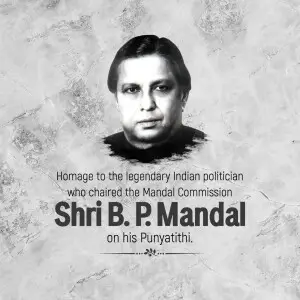The Mandal Commission, officially known as the Socially and Educationally Backward Classes Commission, was a landmark initiative in India’s post-independence history. Constituted in 1979 under the chairmanship of B.P. Mandal, the Commission was tasked with identifying socially and educationally backward classes (SEBCs) and recommending measures for their advancement. Its work significantly altered the discourse on affirmative action, social justice, and caste-based representation in India.
Table of Contents
1. Historical Background
India’s Constitution, while guaranteeing equality before law (Article 14), also empowered the State to make special provisions for the advancement of socially and educationally backward classes (Article 15(4)). Though Scheduled Castes (SCs) and Scheduled Tribes (STs) were recognized early on for reservation benefits, the position of the Other Backward Classes (OBCs) remained under-addressed.
In response to political pressure and constitutional mandates, Prime Minister Morarji Desai established the Mandal Commission on 1 January 1979.

2. Composition and Objectives
- Chairperson: Bindheshwari Prasad Mandal
- Members: Included experts in sociology, education, and public administration
- Mandate:
- Define criteria for identifying socially and educationally backward classes
- List such classes across India
- Recommend steps, including reservation, for their welfare and representation
3. Methodology and Criteria
The Commission used an 11-point indicator system based on three broad categories:
- Social indicators: Traditional occupation, early marriage, caste-based discrimination
- Educational indicators: Literacy rate, school dropouts
- Economic indicators: Family income, landholding, standard of living
A caste needed to meet at least one criterion from each category to be included. The final report identified 3,743 OBC castes.
4. Major Recommendations
- 27% reservation in public sector jobs and educational institutions for OBCs
- Total reservation not to exceed 49.5% (including SC/ST quota)
- Periodic revision of the OBC list
- Special education programs for backward classes
- Creation of a permanent OBC welfare commission
- Introduction of creamy layer exclusion to ensure benefits for the truly disadvantaged
5. Implementation and Political Fallout
Initially sidelined, the report was implemented by Prime Minister V.P. Singh in 1990, sparking widespread protests and social unrest. Students and upper-caste communities opposed the move, arguing it compromised merit.
The matter reached the judiciary in the landmark Indra Sawhney vs. Union of India (1992) case. The Supreme Court upheld the constitutional validity of OBC reservations but imposed certain conditions:
- Reservation ceiling at 50%
- Exclusion of creamy layer within OBCs
- No reservations in promotions (later partially reversed for SC/STs)
6. Impact on Indian Society and Politics
- Political Empowerment: Rise of OBC leaders and parties like SP, RJD, JD(U)
- Caste Mobilization: Caste became a central electoral issue
- Social Justice: Increased representation of backward classes in public services and education
- Judicial Evolution: Mandal Commission became a reference point for all future affirmative action cases
7. Criticism and Challenges
- Reinforcement of Caste Identities: Critics argue it deepened caste divisions
- Neglect of Economic Backwardness: Critics preferred income-based reservations
- Use of 1931 Census Data: Outdated statistics questioned the Commission’s accuracy
- Inconsistent creamy layer implementation across states and institutions
8. Contemporary Relevance
The Mandal Commission’s legacy is visible in modern-day politics and policy debates. Recent developments such as:
- Demand for caste-based census
- Sub-categorization of OBCs for equitable distribution
- Introduction of 10% EWS quota for economically weaker sections (2019)
These underscore the continuing evolution of India’s approach to affirmative action and social justice.
Conclusion
The Mandal Commission represents a watershed in India’s journey toward inclusive governance. Despite facing immense criticism and societal upheaval, it succeeded in institutionalizing the rights of backward classes and shifting the national conversation toward equity. Balancing merit with social justice, and caste with economic realities, continues to be a challenge in India’s democratic journey—but the groundwork laid by the Mandal Commission remains foundational.
Advertisement












